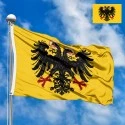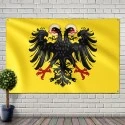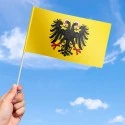Unlike modern states, the Holy Roman Empire (HRE), which existed for over a thousand years (approximately 800/962 to 1806 AD), did not possess a single "national flag" in the sense we commonly understand. Its symbolism evolved organically, reflecting its complex structure, imperial succession, and the constantly changing political landscape. The primary and most recognizable symbol of the Empire for centuries was the imperial eagle – a majestic bird depicted on a gold (yellow) field, whose colors – black and gold – became an integral part of imperial heraldry.
Description and Elements of the Imperial Banner
The main imperial symbol that could loosely be termed a "flag" was the Imperial Banner, or Standard. Most often, it was a gold (yellow) cloth on which a black eagle was depicted. Initially, in the early period of the Empire, the eagle was single-headed. However, starting from the 15th century, influenced by Byzantine symbolism and in an effort to emphasize continuity from the Roman Empire, as well as the universal claims of imperial power, the double-headed eagle began to appear on the banner.
The double-headed eagle on a gold background became the quintessence of imperial symbolism. This eagle was typically depicted with red beaks and claws, sometimes with golden halos (nimbuses) above its heads, emphasizing the sacred and divine nature of the emperor's authority. In its talons, the eagle might hold symbols of power: a scepter and an orb, sometimes a sword. The lack of strict standards in sizes and proportions, characteristic of medieval and early modern heraldry, meant that these banners could vary, but the general composition – a black eagle on gold – remained consistent.
History of Creation and Development of Symbolism
The history of imperial symbolism is intricately intertwined with the history of the Holy Roman Empire itself. Its roots trace back to ancient Rome, where the eagle was the main symbol of legions and imperial power. When Charlemagne was crowned emperor in 800 AD, he sought to revive the Western Roman Empire, and with it came Roman symbolism. However, the formal use of the eagle as a permanent imperial symbol was established later, under the Ottonian dynasty in the 10th century, when the Empire began to be called "Holy."
Throughout the early and high Middle Ages, the single-headed black eagle on a gold shield (or banner) was the recognized coat of arms of the King of the Romans and the Empire. It symbolized the sovereignty and supreme authority of the monarch, as well as the unity of scattered territories under his rule. It is important to note that many princes and cities within the Empire also used the eagle in their coats of arms, emphasizing their vassalage and belonging to the imperial system.
The transition to the double-headed eagle occurred in the 15th century, during the reign of the Habsburgs. The double-headed eagle first appeared in the coat of arms of Emperor Sigismund of Luxembourg in 1433. The two heads of the eagle were often interpreted as a symbol of the Empire's universal claims to power over both East and West, or as a sign of the unification of the emperor's spiritual and temporal authority. Over time, the double-headed eagle became so strongly associated with the Empire that it became its de facto "visual brand" until its dissolution in 1806.
In addition to the main imperial banner, there were other important symbols. For example, the "Imperial War Flag" (Reichssturmfahne), which, according to some sources, originally featured a black eagle on a gold field with a red "schwenkel" (a projecting tail-like strip of cloth). This banner, often smaller, was carried before the emperor or his commanders in battle. However, the use of the black eagle on a gold background remained common to all imperial symbols.
Territories and Regions
The Holy Roman Empire was an exceptionally complex entity that encompassed vast territories in Central Europe. Its borders constantly shifted, but its composition included hundreds of different political units: kingdoms (e.g., Kingdom of Germany, Kingdom of Italy, Kingdom of Bohemia), duchies, principalities, archbishoprics, bishoprics, countships, free imperial cities, imperial abbeys, and small holdings of imperial knights.
At its zenith, the Empire stretched from the North Sea and the Baltic in the north to Central Italy in the south, and from France in the west to Bohemia and parts of Poland in the east. Today, these lands cover modern states such as Germany, Austria, Switzerland, Liechtenstein, Czech Republic, Slovenia, Belgium, Netherlands, Luxembourg, most of Italy (northern and central), eastern regions of France (e.g., Alsace and Lorraine), as well as small parts of Denmark and Poland. This fragmented structure, known as "Kleinstaaterei" (multitude of small states), was one of the characteristic features of the Empire. Despite this, imperial symbols, primarily the eagle, served as a reminder of the nominal unity and supreme authority of the emperor over these diverse lands.
Interesting Facts
-
Absence of a "National" Flag: The most significant fact is that the HRE never had a "national flag" in the modern sense. Instead, personal standards of the emperor, military banners, and coats of arms were used, which were nevertheless recognizable as symbols of imperial power.
-
Influence on Modern Heraldry: The black eagle on a gold field, as well as the double-headed eagle, had a huge influence on the heraldry of many European states. For example, the colors of the Holy Roman Empire (black, red, gold) became the basis for the modern flag of Germany (black-red-gold). The double-headed eagle continues to be a symbol in the coats of arms of countries such as Austria, Russia, Serbia, Albania, as well as many cities and noble families.
-
Imperial Regalia: Besides the banners, there were other crucial symbols of imperial power, known as the Imperial Regalia (Reichskleinodien). These included the Imperial Crown, the Holy Lance, the Imperial Sword, the Imperial Orb, and the Scepter. These relics, many of which had sacred significance, were kept in Nuremberg and later in Vienna, and were used during the coronations of emperors.
-
Symbol of Continuity: The eagle of the Holy Roman Empire was not just a coat of arms, but also a powerful symbol of "Translatio Imperii" – the transfer of the Roman Empire. It linked the HRE with ancient Rome and Byzantium, emphasizing the emperors' claims to universal power and their role as guardians of Christendom.
-
Diversity of Flags: Although the imperial banner with the eagle was central, every prince, duke, city, and even military unit within the Empire had their own flags and banners. This created an incredible diversity of heraldic symbols, reflecting the decentralized nature of the Empire.
Adoption and Significance for Inhabitants
For most inhabitants of the Holy Roman Empire, imperial symbols, especially the eagle, were powerful signs of supreme authority and order. They represented not so much a national symbol as a religious and political one. The Empire saw itself as the successor to the Roman Empire, but its "holiness" emphasized its divine origin and role in the Christian world.
The Emperor, crowned with the imperial eagle, was considered God's anointed, the protector of faith, and the guarantor of peace (Landfrieden) in the lands of the Empire. For ordinary people, the imperial eagle, found on coins, official documents, city gates, and banners, served as a constant reminder of the existence of this higher authority, however distant. It symbolized the idea of order, justice, and belonging to a great, albeit very heterogeneous, Christian state.
At the same time, due to the highly decentralized nature of the Empire, loyalty was often more local – to one's prince, city, or region. Nevertheless, the common eagle symbolism served as a unifying element, allowing imperial troops to be distinguished from others, and imperial cities from princely domains. The eagle was a visual expression of the "umbrella" that the Empire provided for its numerous members. During periods of war or crisis, when cohesion was required, the imperial banner became an important symbol of unity, around which various forces of the Empire could rally.
Thus, while the Holy Roman Empire did not have a "flag" in the modern sense, its imperial banners with the eagle were deeply rooted in the consciousness of its inhabitants as symbols of power, sacredness, and historical continuity, reflecting the unique character of this long-lived European entity.
In the demonstration images, full-size flags are shown with proportions of 2:3, and hand-held flags with proportions of 1:2.






 Waving flag
Waving flag
 Sizes:
Sizes:
 Round flag
Round flag
 Sizes:
Sizes:
 Rectangular flag 2:3
Rectangular flag 2:3
 Sizes:
Sizes: